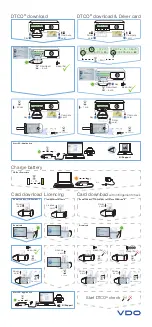
Using the Data Editing Functions
The data editing function is often applied to driver’s licenses, where the
magnetic stripe contains three tracks of information about the license
holder, and the host application may need only certain details (such as
name, address, and birth date) rather than all the data the stripe holds.
In the AAMVA format, for example, the unedited output for a driver’s
license might look like this:
TRACK 1:
%CABREA^DOE$JANE$R$^310 S JEFFERSON ST^?
TRACK 2:
;636014028198457=051219639924?
TRACK 3:
%!!92870 C F503121BLKBRN D69119980116?
Track 1 contains the license holder’s name and address. Track 2 includes
the expiration date and the holder’s birthdate. Track 3 includes such
details as height, weight, sex, hair, and eye color.
You can identify exactly what fields the various bits of data occupy by
referring to the AAMVA format in Appendix E. Read the data from a
sample license, print it out, and then mark the fields accordingly. Now
decide what fields of data you need, and what fields of data you don’t
need. For instance, if you don’t need eye and hair colors, you can discard
this data once it is read and decoded. You don’t need to send it to the
host.
Once you know what data you’ll need for your host application, decide
what order you’ll need it in. Should the name come first? Should the city
come last? Is there other data or formatting you need? If so, you will have
to add fields that contain that data.
Knowing what fields you need to add, drop, and re-arrange will enable
you to make full use of the commands on the following pages.
3 5
3 4
The Formula Sequence
A basic data editing formula for the Omni has the following structure.
(The optional commands are enclosed in brackets):
CODE ID[LENGTH][MATCH]DIVIDE[ADD]SEND
In other words:
1. Identify the bar code symbologies and/or magnetic stripe tracks to
which this formula will apply.
2. Specify data length parameters (if desired).
3. Specify the characters (if any) you would like to match.
4. Indicate how you want to divide the data record.
5. Add a character string (if desired).
6. Send the edited data record to the host computer.
Several code IDs can be specified following the CODE ID command, and
several ADD commands can be programmed as long as they are grouped
together and placed prior to the SEND command.
Note: If Function Codes are to be used with any of the commands, the Function
Code capability must be enabled by typing /E/D/FB<ENTER>B7<ENTER>
A<ENTER>BZ<ENTER> before entering the Data Editing Setup mode.














































